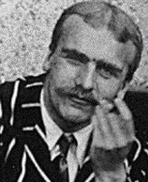Clan Haldane People
James Alexander Haldane (1768 – 1851)
Scottish independent church leader. The younger son of Captain James Haldane of Airthrey House, in Stirlingshire, he was born at Dundee. Educated first at Dundee Grammar School and afterwards at the Royal High School and University of Edinburgh, at the age of seventeen he joined the Duke of Montrose East Indiaman as a midshipman. After four voyages to India he was nominated to the command of the Melville Castle in the summer of 1793; but having begun a careful study of the Bible during his voyages, and also come under the evangelical influence of David Bogue of Gosport, one of the founders of the London Missionary Society, he abruptly decided to leave the navy for a religious life, and returned to Scotland.
In 1799 he was ordained as pastor of a large Independent congregation in Edinburgh. This was the first congregational church known by that name in Scotland. To this church he continued to minister gratuitously for more than fifty years. In 1808 he made public avowal of his conversion to Baptist views. As advancing years compelled him to withdraw from the more exhausting labours of travel and open-air preaching, he sought to influence the discussion of current religious and theological questions by means of the press.
John Burdon Sanderson (J.B.S.) Haldane (1892 – 1964)
British geneticist and evolutionary biologist. He was one of the founders of population genetics. Haldane was born in Edinburgh descended from Scottish aristocrats. His younger sister Naomi Mitchison became a writer. Haldane was educated at Dragon School, Eton College and at New College, Oxford.
During the First World War, he served with the Black Watch in France and Iraq. Between 1919 and 1922 he was a fellow of New College, then moved to Cambridge University then to University College, London where he spent most of the remainder of his academic career. In the late 1950s he moved to India.The move was ostensibly a protest against the Suez War, but had been a possibility for some while.
In 1925, Briggs and Haldane derived a superior form of the 1913 Michaelis-Menten equation, still a mainstay of enzyme kinetics in biochemistry. Haldane made many contributions to human genetics and was one of the three major figures to develop the mathematical theory of population genetics.
Haldane was a keen experimenter, willing to expose himself to danger to obtain data. One experiment involving elevated levels of oxygen saturation triggered a fit which resulted in him suffering crushed vertebrae. In his decompression chamber experiments, he and his volunteers suffered perforated eardrums, but, as Haldane stated in What is Life, “the drum generally heals up; and if a hole remains in it, although one is somewhat deaf, one can blow tobacco smoke out of the ear in question, which is a social accomplishment.”
Haldane was a friend of the author Aldous Huxley, and was the basis for the biologist Shearwater in Huxley’s novel Antic Hay. Ideas from Haldane’s Daedalus, such as ectogenesis (the development of fetuses in artificial wombs), also influenced Huxley’s Brave New World. Haldane died on December 1, 1964. He willed that his body be used for study at the Rangaraya Medical College, Kakinada.
Archibald Richard Burdon Haldane (1900 – 1982)
Scottish social historian and writer. He was the son of Edith (née Nelson) and Sir William Haldane, grandson of James Alexander Haldane, and nephew of Richard Burdon Haldane, 1st Viscount Haldane. His brother was Graeme Haldane and he married Janet Macrae Simpson-Smith.
Like his father and uncles, he attended the Edinburgh Academy, after which he went up to Balliol College, Oxford to read history. He returned to Scotland to enter his father’s legal firm and acted for a time as Fiscal to the Society of Writers to the Signet. He then became involved in the Savings Bank movement and was at one stage vice-chairman of the Savings Bank Association. In 1982, he was awarded the CBE in recognition of his work for the bank.
He was principally known, however, as a social historian and author, and for his seminal work on the drove roads of Scotland. In recognition for his work in this field, he was awarded the honorary degree of D Litt from the University of Edinburgh. He published two further books in this field, New Ways through the Glens and Three centuries of Scottish posts, as well as several on his favourite pastime of trout fishing, of which he was passionately fond.






